1997 GMC SIERRA automatic transmission
[x] Cancel search: automatic transmissionPage 75 of 436
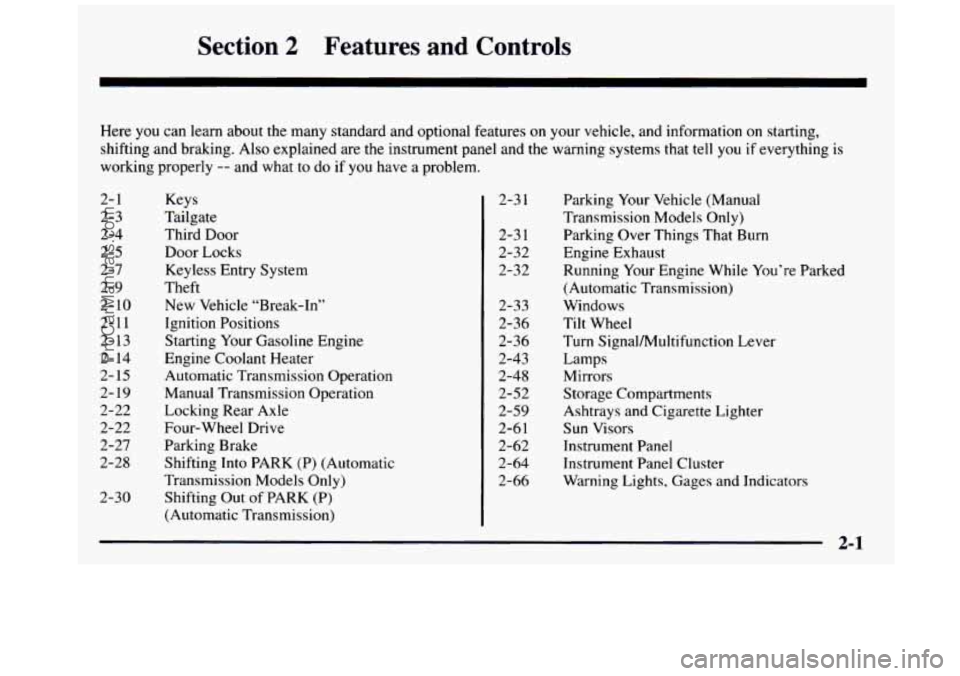
Section 2 Features and Controls
-
Here you can learn about the many standard and optional features on your vehicle, and information on starting,
shifting and braking. Also explained
are the instrument panel and the warning systems that tell you if everything is
working properly
-- and what to do if you have a problem.
2- 1
2-3
2-4
2-5
2-7 2-9
2- 10
2-11
2- 13
2- 14
2- 15
2- 19
2-22
2-22
2-27
2-28
2-30
Keys
Tailgate
Third Door
Door Locks
Keyless Entry System
Theft
New Vehicle “Break-In” Ignition Positions
Starting Your Gasoline Engine
Engine Coolant Heater
Automatic Transmission Operation
Manual Transmission Operation
Locking Rear Axle
Four-wheel Drive
Parking Brake
Shifting Into PARK
(P) (Automatic
Transmission Models Only)
Shifting Out
of PARK (P)
(Automatic Transmission) 2-3
1
2-3 1
2-32
2-32
2-33
2-36
2-36
2-43 2-48
2-52
2-59
2-6
1
2-62
2-64 2-66 Parking
Your Vehicle (Manual
Transmission Models Only)
Parking Over Things That Burn
Engine Exhaust
Running Your Engine While You’re Parked
(Automatic Transmission)
Windows
Tilt Wheel
Turn SignalAUultifunction Lever
Lamps
Mirrors Storage Compartments
Ashtrays and Cigarette Lighter
Sun Visors
Instrument Panel
Instrument Panel Cluster
Warning Lights, Gages and Indicators
ProCarManuals.com
Page 84 of 436
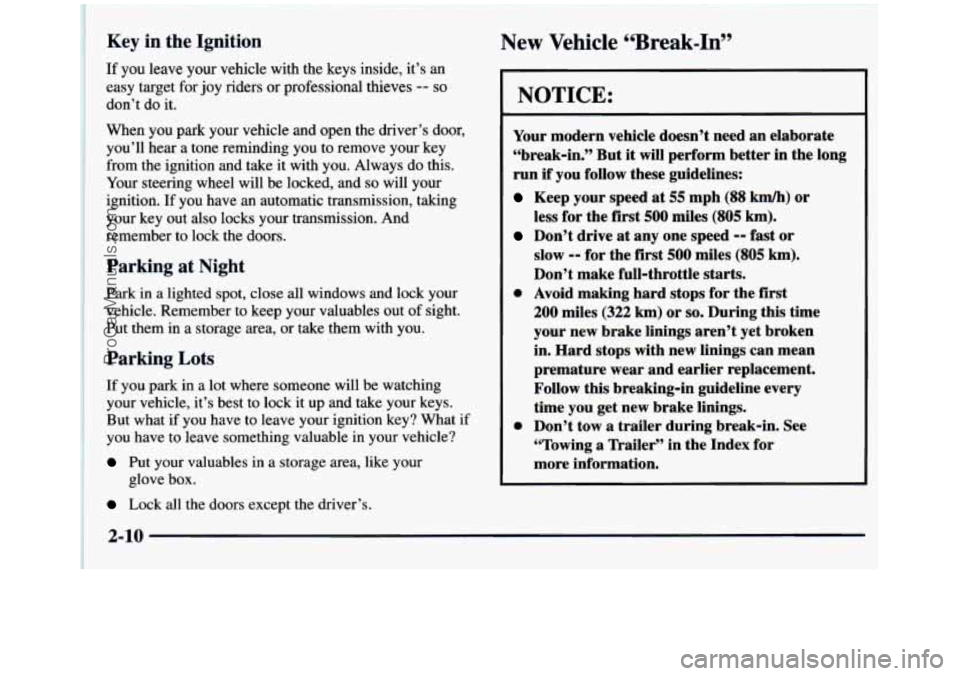
~ ~~~~~ ~~~~~~~~~~~~
~ ~~ -~ ~
Key in the Ignition
If you leave your vehicle with the keys inside, it’s an
easy target for
joy riders or professional thieves -- so
don’t do it.
When you park your vehicle and open the driver’s door, you’ll hear a tone reminding you to remove your key
from the ignition and take it with you. Always do this.
Your steering wheel will be locked, and
so will your
ignition.
If you have an automatic transmission, taking
your key out also locks your transmission. And
remember to lock the doors.
Parking at Night
Park in a lighted spot, close all windows and lock your
vehicle. Remember
to keep your valuables out of sight.
Put them in a storage area, or take them with you.
Parking Lots
If you park in a lot where someone will be watching
your vehicle, it’s best to lock it
up and take your keys.
But what
if you have to leave your ignition key? What if
you have to leave something valuable in your vehicle?
Put your valuables in a storage area, like your
glove box.
Lock all the doors except the driver’s.
New Vehicle “Break-In”
NOTICE:
Your modern vehicle doesn’t need an elaborate
“break-in.” But it will perform better in the long
run
if you follow these guidelines:
Keep your speed at 55 mph (88 km/h) or
less for the first
500 miles (805 km).
Don’t drive at any one speed -- fast or
slow
-- for the first 500 miles (805 km).
Don’t make full-throttle starts.
200 miles (322 km) or so. During this time
your new brake linings aren’t yet broken
in. Hard stops with new linings can mean
premature wear and earlier replacement.
Follow this breaking-in guideline every
time you get new brake linings.
0 Don’t tow a trailer during break-in. See
“Towing a Trailer’’ in the Index for
more information.
a Avoid making hard stops for the first
2-10
ProCarManuals.com
Page 86 of 436
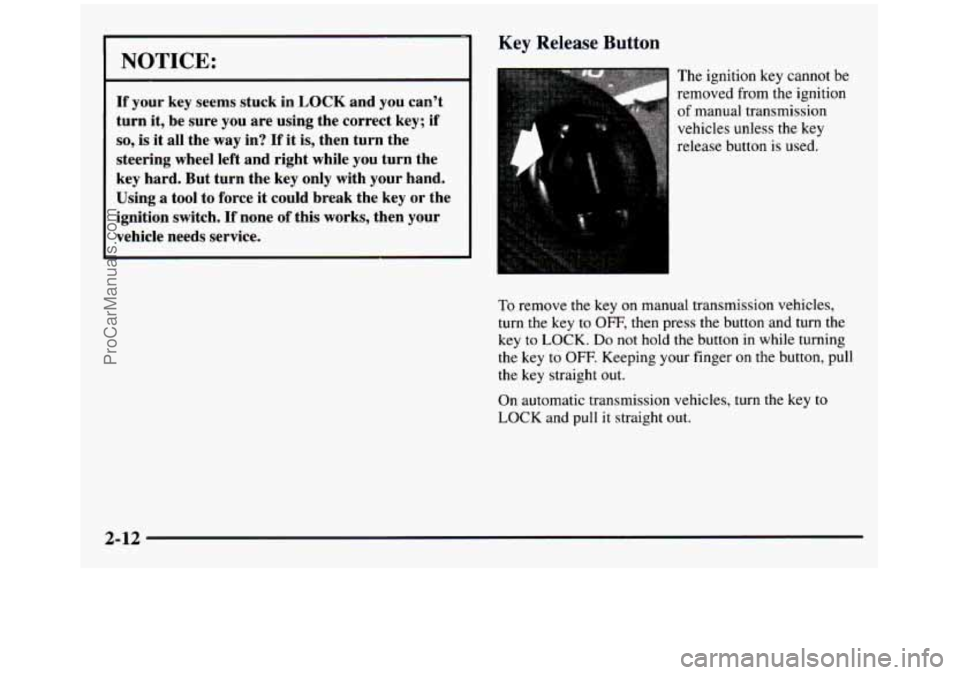
I NOTICE: I
If your key seems stuck in LOCK and you can’t
turn it, be sure
you are using the correct key; if
so, is it all the way in? If it is, then turn the
steering wheel left and right while you turn the
key hard. But turn the key only with your hand.
Using
a tool to force it could break the key or the
ignition switch. If none of this works, then your
vehicle needs service.
Key Release Button
of manual transmiss~on
vehicles unless the key
release button
is used.
To remove the key on manual transmission vehicles,
turn the key to
OFF, then press the button and turn the
key to
LOCK. Do not hold the button in while turning
the key to
OFF. Keeping your finger on the button, pull
the key straight out.
On automatic transmission vehicles, turn the key to
LOCK and pull it straight out.
2-12
ProCarManuals.com
Page 87 of 436
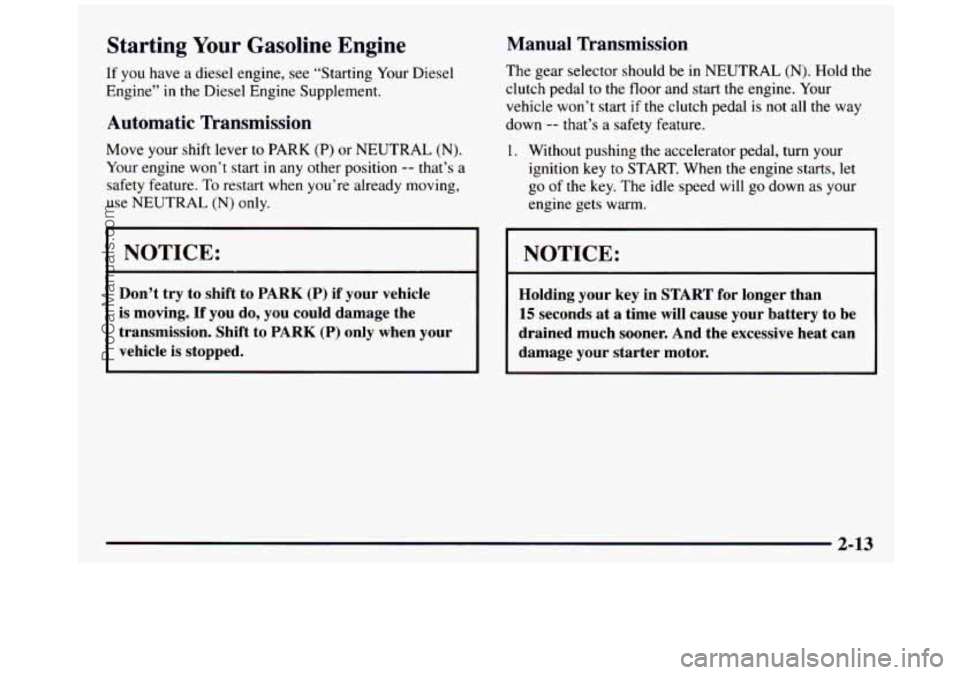
Starting Your Gasoline Engine
If you have a diesel engine, see “Starting Your Diesel
Engine”
in the Diesel Engine Supplement.
Automatic Transmission
Move your shift lever to PARK (P) or NEUTRAL (N).
Your engine won’t start in any other position -- that’s a
safety feature. To restart when you’re already moving,
use NEUTRAL
(N) only.
Manual Transmission
The gear selector should be in NEUTRAL (N). Hold the
clutch pedal to the floor and start the engine. Your
vehicle won’t start
if the clutch pedal is not all the way
down -- that’s a safety feature.
1. Without pushing the accelerator pedal, turn your
ignition key to START. When the engine starts, let
go of the key. The idle speed will go down as your
engine gets warm.
NOTICE:
NOTICE:
I I I I
Don’t try to shift to PARK (P) if your vehicle
is moving.
If you do, you could damage the Holding your key in START
for longer than
damage your starter motor.
vehicle is stopped. drained
much sooner. And the excessive heat can
transmission. Shift
to PARK
(P) only when your
15 seconds at a time will cause your battery to be
ProCarManuals.com
Page 89 of 436
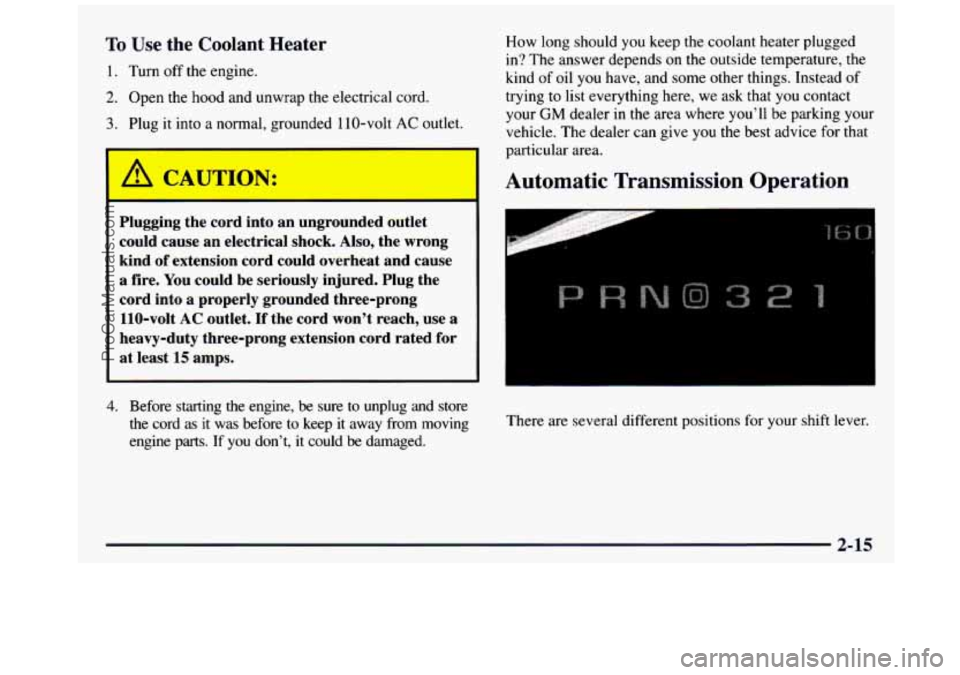
To Use the Coolant Heater
1. Turn off the engine.
2. Open the hood and unwrap the electrical cord,
3. Plug it into a normal, grounded 110-volt AC outlet.
I
I
Plugging the cord into an ungrounded outlet
could cause an electrical shock. Also, the wrong
kind
of extension cord could overheat and cause
a fire. You could be seriously injured. Plug the
cord into a properly grounded three-prong
110-volt
AC outlet. If the cord won’t reach, use a
heavy-duty three-prong extension cord rated for
at least
15 amps.
How long should you keep the coolant heater plugged
in? The answer depends
on the outside temperature, the
kind of oil you have, and some other things. Instead
of
trying to list everything here, we ask that you contact
your
GM dealer in the area where you’ll be parking your
vehicle. The dealer can give you the best advice
for that
particular area.
Automatic Transmission Operation
4. Before starting the engine, be sure to unplug and store
the cord as
it was before to keep it away from moving
engine
parts. If you don’t, it could be damaged. There are
several different positions for your shift lever.
ProCarManuals.com
Page 90 of 436
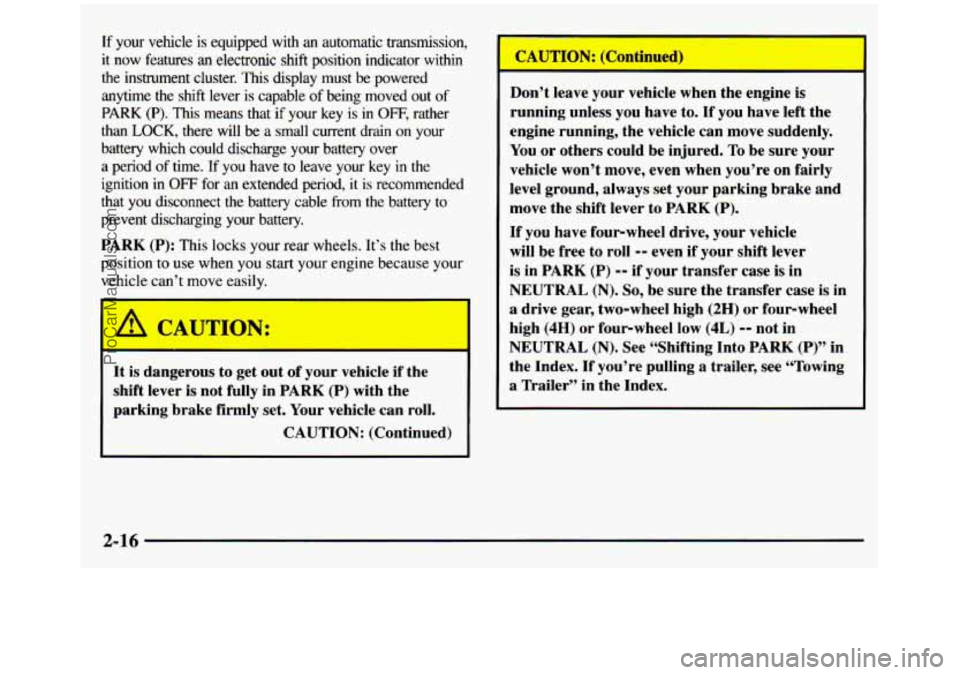
If your vehcle is equipped with an automatic transmission,
it now features an electronic shift position indicator within
the instrument cluster. This display must be powered
anytime the
shift lever is capable of being moved out of
PARK (P). This means that if your key is in OFF, rather
than
LOCK, there will be a small current drain on your
battery which could discharge your battery over
a period
of time. If you have to leave your key in the
ignition
in OFF for an extended period, it is recommended
that you disconnect the battery cable from the battery to
prevent discharging your battery.
PARK
(P): This locks your rear wheels. It’s the best
position to use when you start your engine because your
vehicle can’t move easily.
It is dangerous to get out of your vehicle if the
shift lever is not fully in PARK
(P) with the
parking brake firmly set. Your vehicle can roll.
CAUTION: (Continued)
I
Don’t leave your vehicle when the engine is
running unless you have to. If you have left the
engine running, the vehicle can move suddenly.
You or others could be injured. To be sure your
vehicle won’t move, even when you’re on fairly
level ground,
always set your parking brake and
move the shift lever to PARK
(P).
If you have four-wheel drive, your vehicle
will be free to roll -- even if your shift lever
is in PARK
(P) -- if your transfer case is in
NEUTRAL
(N). So, be sure the transfer case is in
a drive gear, two-wheel high
(2H) or four-wheel
high
(4H) or four-wheel low (4L) -- not in
NEUTRAL
(N). See “Shifting Into PARK (P)” in
the Index.
If you’re pulling a trailer, see “Towing
a Trailer” in the Index.
2-16
ProCarManuals.com
Page 92 of 436
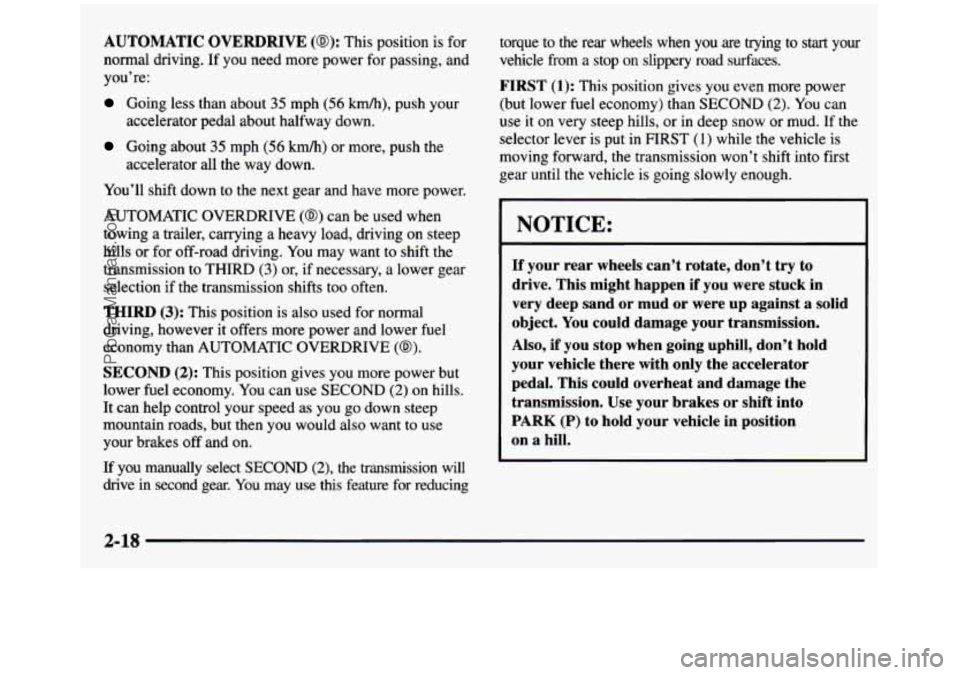
AUTOMATIC OVERDRIVE (@): This position is for
normal driving. If you need more power for passing, and
you’re:
Going less than about 35 mph (56 km/h), push your
Going about 35 mph (56 km/h) or more, push the
accelerator
pedal about halfway down.
accelerator all
the way down.
You’ll shift down to the next gear and have more power.
AUTOMATIC OVERDRIVE
(a) can be used when
towing
a trailer, carrying a heavy load, driving on steep
hills or for off-road driving.
You may want to shift the
transmission to THIRD
(3) or, if necessary, a lower gear
selection if the transmission shifts too often.
THIRD (3): This position is also used for normal
driving, however it offers more power and lower
fuel
economy than AUTOMATIC OVERDRIVE (a).
SECOND (2): This position gives you more power but
lower fuel economy.
You can use SECOND (2) on hills.
It can help control your speed as you go down steep
mountain roads, but then you would also want
to use
your brakes
off and on.
If you manually select SECOND (2)’ the transmission will
drive in
second gear. You may use this feature for reducing torque to the rear wheels when you are trying
to start your
vehicle from a stop on slippery road surfaces.
FIRST (1): This position gives you even more power
(but lower fuel economy) than
SECOND (2). You can
use it on very steep hills, or in deep snow or mud. If the
selector lever is
put in FIRST (1) while the vehicle is
moving forward,
the transmission won’t shift into first
gear until the vehicle
is going slowly enough.
NOTICE:
~ ~~
If your rear wheels can’t rotate, don’t try to
drive. This might happen if you were stuck in
very deep sand or mud or were up against
a solid
object. You could damage your transmission.
Also, if you stop when going uphill, don’t hold
your vehicle there with only the accelerator
pedal. This could overheat and damage the
transmission. Use your brakes or shift into
PARK (P) to hold your vehicle in position
on a hill.
2-18
ProCarManuals.com
Page 98 of 436
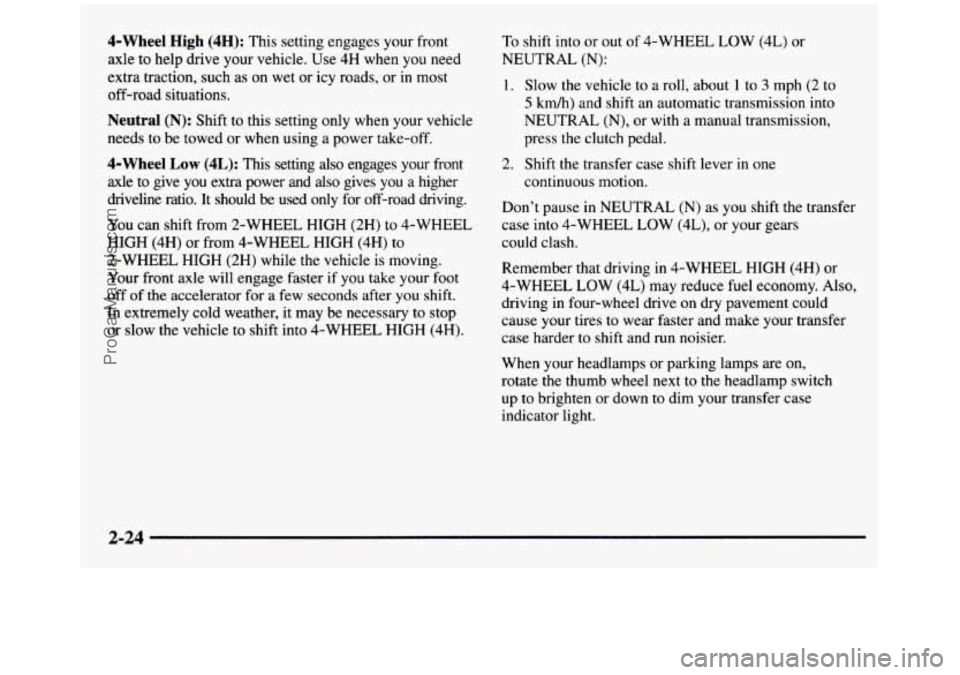
$-Wheel High (4H): This setting engages your front
axle
to help drive your vehicle. Use 4H when you need
extra traction, such as on wet or icy roads, or in most
off-road situations.
Neutral (N): Shift to this setting only when your vehicle
needs to be towed or when using a power take-off.
4-Wheel Low (4L): This setting also engages your front
axle to give you extra power and also gives you a higher
driveline ratio. It should
be used only for off-road driving.
You can shift from 2-WHEEL HIGH (2H) to 4-WHEEL
HIGH (4H) or from 4-WHEEL HIGH
(4H) to
2-WHEEL HIGH (2H) while the vehicle is moving.
Your front axle will engage faster if
you take your foot
off of the accelerator for a few seconds after you shift.
In extremely cold weather, it may be necessary
to stop
or slow the vehicle
to shift into 4-WHEEL HIGH (4H). To
shift into or out of 4-WHEEL LOW (4L) or
NEUTRAL
(N):
1. Slow the vehicle to a roll, about 1 to 3 mph (2 to
5 kmh) and shift an automatic transmission into
NEUTRAL (N), or with a manual transmission,
press the clutch pedal.
2. Shift the transfer case shift lever in one continuous motion.
Don’t pause in NEUTRAL
(N) as you shift the transfer
case into 4-WHEEL LOW (4L), or your gears
could clash.
Remember that driving in 4-WHEEL HIGH (4H) or
4-WHEEL LOW (4L) may reduce fuel economy.
Also,
driving in four-wheel drive on dry pavement could
cause your tires to wear faster and make your transfer
case harder to shift and run noisier.
When your headlamps or parking lamps are on,
rotate the thumb wheel next to the headlamp switch
up to brighten or down
to dim your transfer case
indicator light.
2-24
ProCarManuals.com